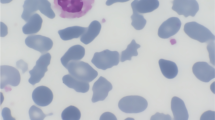Abstract
Red blood cells of 17 patients out of seven families diagnosed with HS from the southwest of Poland were studied. In six families a deficiency of ankyrin was detected, and in one family a band 3 (anion-exchanger protein) deficiency was detected. Patients from six families with the ankyrin deficiency had a 19–51% decrease in ankyrin 2.1, while the family with the band 3 deficiency showed a 33% decrease in this protein content. All changes were statistically significant, as analysed by the Student t test (P<0.05). Analysis of haemolysis kinetics gives a reliable indication of altered osmotic properties of the spherocytic cells.




Similar content being viewed by others
References
Bogusławska DM, Heger E, Chorzalska A, Nierzwicka M, Hołojda J, Świderska A, Straburzyńska A, Chmura A, Langner M, Sikorski AF (2002) Identification of several families with hereditary spherocytosis in a population from South-West Poland. Cell Mol Biol Lett 7[Suppl]: 174
Delaunay J, Alloisio N, Morle L (1996) Molecular genetics of hereditary spherocytosis. Cell Mol Biol Lett 1:49–65
Dhermy D, Galand C, Bournier O, Boulanger L, Cynober T, Schismanoff PO, Bursaux E, Tchernia G, Boivin P, Garbarz M (1997) Heterogenous band 3 deficiency in hereditary spherocytosis related to different band 3 gene defects. Br J Haematol 98:32–40
Dodge JT, Mitchell C, Hanahan DJ (1963) The preparation and chemical characteristics of hemoglobin-free ghosts of human erythrocyte membrane. Arch Biochem 100:119–130
Eber SW, Armbrust R, Schroter W (1990) Variable clinical severity of hereditary spherocytosis: relation to erythrocytic spectrin concentration, osmotic fragility, and autohemolysis. J Pediatr 117:409–416
Eber SW, Gonzales JM, Lux ML, Scarpa AL, Tse WT, Dornwell M, Herbers J, Kugler W, Ozcan R, Pekrun A, Gallagher PG, Schroter W, Forget BG, Lux SE (1996) Ankyrin-1 mutations are a major cause of dominant and recessive hereditary spherocytosis. Nature Genet 13:214–218
Gallagher PG, Sabatino DE, Basseres DS, Nilson DM, Wong C, Cline AP, Garrett LJ, Bodine DM (2001) Erythrocyte ankyrin promoter mutations associated with recessive hereditary spherocytosis cause significant abnormalities in ankyrin expression. J Biol Chem 276:41683–41689
Inoue T, Kanzaki A, Yawata A, Wada H, Okamoto N, Takahashi M, Sugihara T, Yamada O, Yawata Y (1994) Uniquely higher incidence of isolated or combined deficiency of band 3 and/or band 4.2 as the pathogenesis of autosomal dominantly inherited hereditary spherocytosis in the Japanese population. Int J Hematol 60:227–238
Jarolim P, Rubin HL, Brabec V, Palek J (1995) A nonsense mutation 1669Glu->Ter within the regulatory domain of human erythroid ankyrin leads to a selective deficiency of the major ankyrin isoform (band 2.1) and a phenotype of autosomal dominant hereditary spherocytosis. J Clin Invest 95:941–947
Jarolim P, Murray JL, Rubin HL, Taylor WM, Prchal JT, Ballas SK, Snyder LM, Chrobak L, Melrose WD, Brabec V, Palek J (1996) Characterization of 13 novel band 3 gene defects in hereditary spherocytosis with band 3 deficiency. Blood 88:4366–4374
Laemmli UK (1970) Cleavage of structural proteins during the assembly of the head of bacterophage T4. Nature 227:680–685
Lanciotti M, Perutelli P, Valetto A, Di Martino D, Mori PG (1997) Ankyrin deficiency is the most common defect in dominant and non dominant hereditary spherocytosis. Haematologica 82:460–462
Leite RC, Basseres DS, Ferreira JS, Alberto FL, Costa FF, Saad ST (2000) Low frequency of ankyrin mutations in hereditary spherocytosis: identification of three novel mutations. Hum Mutat 16:529
Miraglia del Giudice E, Iolascon A, Pinto L, Nobili B, Perrotta S (1994) Erythrocyte membrane protein alterations underlying clinical heterogeneity in hereditary spherocytosis. Br J Haematol 88:52–55
Miraglia del Giudice E, Francese M, Nobili B, Morle L, Cutillo S, DElaunay J, Perrotta S (1998) High frequency of de novo mutations in ankyrin gene (ANK1) in children spherocytosis. J Pediatr 132:117–120
Miraglia del Giudice E, Nobili B, Francese M, D'Urso L, Iolascon A, Eber S, Perrotta S (2001) Clinical and molecular evaluation of non-dominant hereditary spherocytosis. Br J Haematol 112:42–47
Paździor G, Langner M., Chmura A, Bogusławska D, Heger E, Chorzalska A, Sikorski AF (2003) Kinetics of haemolysis of spherocytic erythrocytes. Cell Mol Biol Lett 8:639–648
Tse WT, Lux SE (1999) Red blood cell membrane disorders. Brit J Haematol 104:2–13
Author information
Authors and Affiliations
Corresponding author
Additional information
Portions of these results have been previously presented in an abstract form at the VIII Polish Conference on Cell Biology, Wrocław, 2002 [1]
Rights and permissions
About this article
Cite this article
Bogusławska, D.M., Heger, E., Chorzalska, A. et al. Hereditary spherocytosis: identification of several HS families with ankyrin and band 3 deficiency in a population of southwestern Poland. Ann Hematol 83, 28–33 (2004). https://doi.org/10.1007/s00277-003-0739-5
Received:
Accepted:
Published:
Issue Date:
DOI: https://doi.org/10.1007/s00277-003-0739-5




